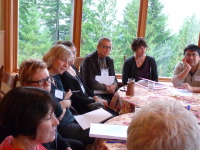 I have spent the last three days in the grasp of a flu and cold. Body aches. Chills. Fatigue. Coughing. Raw throat. Runny nose. Watery eyes. You get the picture. I’m glad this doesn’t happen often, but the last three days have been full on.
I have spent the last three days in the grasp of a flu and cold. Body aches. Chills. Fatigue. Coughing. Raw throat. Runny nose. Watery eyes. You get the picture. I’m glad this doesn’t happen often, but the last three days have been full on.
Today, hopefully, the turning point that I feel this morning will hold through the day. I will be released into relief. Not fully better. Just beyond the thickest and most fatiguing parts.
I learned a lot about the kind of sick person I am over the last three days. Indulge me. One is that I’m the kind of sick person that appreciates being alone. I like to find a place to lay down, be completely quiet, and lick my wounds so to speak. If I were the USS Enterprise in a Star Trek episode, I just need to slow down to impulse power. Nothing near warp speeds that so regularly define my days.
So as not to sound only like a completely geeked Trekkie, I am coming to really value periods of slowing down. Not just as imposition from a flu, as the last three days have been — that is a different category — but as deliberate strategy for overall well-being. Emptying my mind. Letting go of todo lists. Not filling every available moment of time with something productive. I’m more productive when I’m less productive, if that makes sense.
Much of my thinking lately has been about presence, presence as core competency. With a friend that I’ve started writing with, we have asserted that presence is “the” core competency. In the 24/7 ever-on world in which most of us live and work, tenacity has trumped presence, rendering its need nearly invisible. He or she that gets the most done wins. I’ve long admired the nobility of such tenacity. It has a buzz to it, doest it. I find, these days, that that buzz, unchecked, is a trap. It is a kind of seduction. It can take many of us away from an essential grounding, an essential presence that I believe most humans want to feel, need to feel.
I’m hopeful in this day. Just for a relief. Just for a turning of the corner. And for the picture of presence-making that is more commonly grasping and grounding me.

 time. “Time has never heard of me, never will, or even need to.” As personal as I, and I believe many others, make it — “time is not on my side,” “time is a master,” “time is unforgiving” — and, as commoditized as I make it — “I don’t have enough of it” — time is simply a human creation. A construct. A handy system of measurement. Not the general quality of seasonal time. Not the kairos version of time beyond time. These are the kinds of time that I want to give my true devotion. Where I would like to change my relationship to time is in the obsession of ticking seconds, compressed minutes, and of cramming in the most possible to a limited window. It’s revered, I know. And I admit, there is a buzz to having some capacity to do it. Yet something feels deeply amiss in this for me. It is no different that over-stuffing a suitcase. Sometime it is essential, but let’s face it, sometimes good things must stay behind. Just thinking it doesn’t create an expandable zipper compartment.
time. “Time has never heard of me, never will, or even need to.” As personal as I, and I believe many others, make it — “time is not on my side,” “time is a master,” “time is unforgiving” — and, as commoditized as I make it — “I don’t have enough of it” — time is simply a human creation. A construct. A handy system of measurement. Not the general quality of seasonal time. Not the kairos version of time beyond time. These are the kinds of time that I want to give my true devotion. Where I would like to change my relationship to time is in the obsession of ticking seconds, compressed minutes, and of cramming in the most possible to a limited window. It’s revered, I know. And I admit, there is a buzz to having some capacity to do it. Yet something feels deeply amiss in this for me. It is no different that over-stuffing a suitcase. Sometime it is essential, but let’s face it, sometimes good things must stay behind. Just thinking it doesn’t create an expandable zipper compartment.
